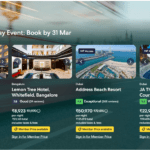
Travel can be more than just ticking landmarks off a list or capturing Instagram-worthy photos. While sightseeing is a valid part of the experience, the true essence of travel lies in cultural immersion—blending into a destination, understanding its people, and discovering daily life from a local’s perspective. This approach not only broadens your worldview but also enriches your travel memories with authenticity and depth.
If you’re ready to travel like a local rather than a tourist, here’s how you can fully immerse yourself in the culture of your next destination.
1. Rethink Where You Stay
One of the most effective ways to immerse yourself in a culture is by staying where locals live.
Choose Homestays or Guesthouses
Opting for a homestay or small guesthouse over a traditional hotel allows you to interact closely with locals. Whether it’s chatting with your host over breakfast or learning about customs from the family you’re staying with, these experiences give you a real glimpse into everyday life.
Consider Alternative Accommodations
Platforms like Airbnb often offer options in residential neighborhoods. This allows you to explore local markets, bakeries, and coffee shops—places you might never encounter in a tourist district.
2. Learn the Language—Even Just a Little
You don’t need to be fluent in the local language, but learning a few key phrases can go a long way.
Start With Basics
Greetings, “please,” “thank you,” and simple questions like “Where is…?” or “How much is this?” can break the ice and show locals that you respect their culture.
Language Apps Are Your Friend
Use apps like Duolingo, Babbel, or even Google Translate to practice pronunciation and expand your vocabulary. Locals often appreciate the effort and may respond more openly, even helping you learn more.
3. Eat Where Locals Eat
Dining is a window into a culture’s soul. Instead of dining at chain restaurants or tourist-centered eateries, seek out places where the locals go.
Explore Street Food
Street food is often the most authentic and delicious way to experience local cuisine. Not only is it budget-friendly, but it also reflects regional tastes and cooking traditions.
Ask for Recommendations
Don’t hesitate to ask a taxi driver, shop owner, or your host where they eat. Chances are, they’ll point you to a hidden gem you won’t find in guidebooks.
Visit Local Markets
Markets are treasure troves of local flavor, both literally and culturally. From fresh produce and spices to handmade snacks, exploring a bustling market connects you directly to the community.
4. Use Public Transportation
Public transportation offers more than convenience; it’s a cultural experience in itself.
Observe and Learn
On a bus or metro, you’ll witness daily life—commuters, students, street performers—and get a sense of how the city moves. Pay attention to the unspoken rules: Are people quiet? Do they give up seats for elders? These nuances can be eye-opening.
Interact Authentically
Taking public transport can lead to impromptu conversations or helpful guidance from locals. It also challenges you to navigate unfamiliar systems, offering a deeper understanding of the city’s rhythm.
5. Attend Local Events and Festivals
Whether it’s a religious ceremony, a local concert, or a neighborhood market day, participating in local events puts you at the heart of community life.
Research Ahead of Time
Use online event calendars, local tourism boards, or social media groups to find out what’s happening during your visit.
Be Respectful
If you’re attending a cultural or religious event, be sure to observe customs—this may include dress codes, photography restrictions, or behavioral norms.
Participating respectfully will not only enhance your experience but often wins the respect and warmth of the locals.
6. Take a Class or Workshop
Learning a local skill deepens your connection to the culture in a hands-on way.
Cooking Classes
Prepare traditional dishes with a local chef. You’ll gain insight into regional ingredients, family recipes, and food customs.
Art and Craft Workshops
From batik painting in Indonesia to pottery in Mexico, artisan workshops give you a tactile sense of local creativity and heritage.
Dance or Music Lessons
Try flamenco in Spain or drumming in West Africa. Engaging in performance art brings you closer to the cultural heartbeat of a community.
7. Slow Down and Be Present
Cultural immersion isn’t something you can rush. You need to slow down, observe, and interact.
Spend More Time in Fewer Places
Instead of cramming your itinerary with multiple cities or countries, focus on fewer destinations and stay longer. This allows you to form deeper relationships and discover hidden layers of the culture.
Be Spontaneous
Allow room in your schedule for unplanned moments—whether it’s joining a neighborhood soccer match or sitting at a café watching life go by. These unscripted experiences often become the most memorable.
8. Volunteer or Participate in Community Projects
Volunteering can provide meaningful interactions and insight into the challenges and strengths of a community.
Choose Ethical Opportunities
Look for organizations that are locally run and truly benefit the community. Avoid “voluntourism” that may do more harm than good.
Focus on Learning, Not Saving
You’re there to contribute humbly and learn, not to “fix” things. Be open, listen, and use the experience to build empathy and understanding.
9. Connect With Locals Through Technology
In the digital age, it’s easier than ever to meet locals, even before your trip begins.
Apps and Platforms
Use platforms like Meetup, Couchsurfing, or even Facebook groups to find language exchanges, walking tours, or local hangouts.
Virtual Experiences
If you’re preparing for a trip or unable to travel physically, virtual cultural exchanges and cooking classes can help set the stage for real-life immersion later.
10. Respect the Culture
Cultural immersion is about appreciation, not appropriation. It’s crucial to approach other cultures with humility, curiosity, and respect.
Do Your Research
Before arriving, read up on social etiquette, religious practices, and cultural norms. What’s considered polite or rude? What are the local taboos?
Dress Appropriately
Wearing culturally sensitive clothing shows respect. Especially in conservative regions, this can influence how you’re received and whether you’re allowed into certain places.
Ask Before Taking Photos
Not everyone wants to be photographed, and in some places, it’s considered invasive or disrespectful. Always ask first, especially in sacred spaces or when capturing people’s daily lives.
11. Support Local Businesses
Your spending choices can reflect your commitment to immersion and ethical travel.
Buy Handcrafted Goods
Instead of mass-produced souvenirs, look for locally made crafts, textiles, or artwork. It’s not only a more meaningful keepsake but also supports artisans directly.
Use Local Services
Hire local guides, eat at family-run restaurants, and shop at community-owned stores. These interactions often lead to deeper cultural insights and help sustain the local economy.
12. Reflect and Share Thoughtfully
After your trip, take time to reflect on what you’ve learned and how the experience may have shifted your perspective.
Journal Your Experiences
Write about your impressions, the people you met, and moments that challenged your assumptions. Journaling helps you retain meaningful experiences and better appreciate them later.
Share Responsibly
If you’re posting on social media, avoid exoticizing or romanticizing the culture. Focus on storytelling that uplifts and respects the people and places you visited.
Final Thoughts
Cultural immersion isn’t about pretending to be a local—it’s about approaching a place with an open heart and mind. It’s about stepping out of your comfort zone and into someone else’s world with respect, empathy, and curiosity. When you travel this way, the rewards are deeper connections, transformative experiences, and a richer understanding of humanity.
So on your next journey, slow down. Taste the food, learn the language, listen to the stories—and you just might return home changed in the most beautiful way.






















